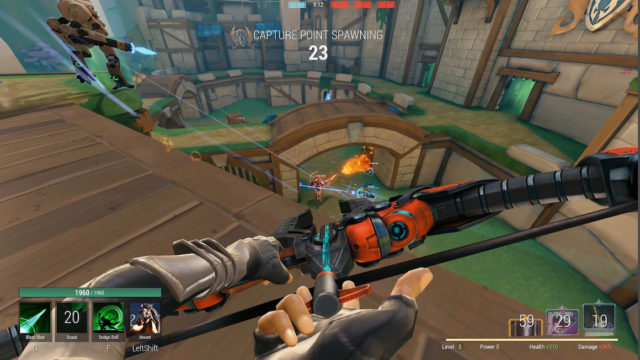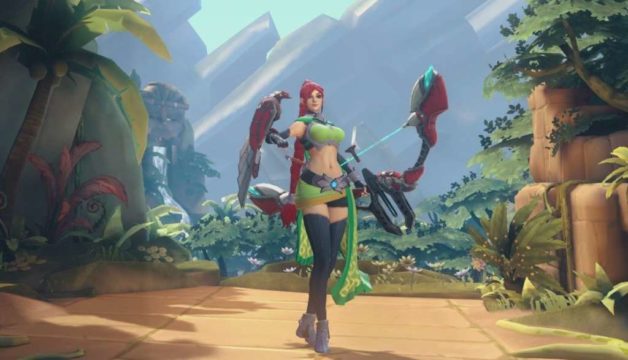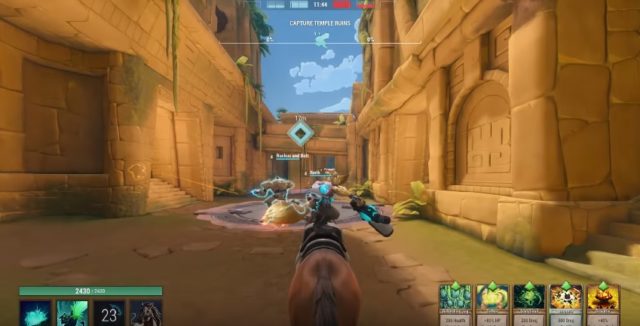Lots of modes; Champions are diverse and fun; progression system isn't based on "pay-to-win"; huge replayability- you'll keep coming back for more; no notable hitches while playing online
Matchmaking can drag; some Champions just aren't fun to play as or are too impractical; movement speed is a little slow; learning curve can be tough
I’ll admit, I wasn’t quite sure what to expect from Hi-Rez Studio’s Switch version of Paladins: Champions of the Realm before this past year’s E3. There, I was escorted to a kiosk where I played the game with seven other people. As I waited to play, I mulled over what I saw in the reveal trailer and my own knowledge of what the title is about. I knew that Paladins is often (both in nice and not-so-nice ways) compared to Blizzard’s Overwatch, with its bright, cartoonish characters and team-based combat, but I also know that there are those who also liken it to Valve’s Team Fortress 2 (indeed, Hi-Rez COO Todd Harris has openly stated that TF2 is the primary inspiration for the game). I’d never personally played Paladins prior to my time at E3, so I went into the demo with fresh eyes.
From the first match, I was hooked. Paladins does indeed have similarities to Overwatch, but it’s more of an optics thing than anything else. The characters (dubbed Champions) are bright, charismatic, and look like they were pulled straight from an animated movie. The game world is much the same, with bright flourishes of color and exotic locales that perfectly reflect the characters doing battle. In truth, besides Overwatch, the aesthetics really pulled Activision’s Skylanders games to the front of my mind. While the gritty military shooter is still the overarching standard for online, multiplayer shooters, it’s nice to see games like Paladins go in the opposite direction and produce something more energetic and fun.
Paladins‘ gameplay revolves around three multiplayer modes: Team Deathmatch, Siege, and Onslaught. Team Deathmatch is the standard team versus team setup seen in countless other games, with the first squad that reaches forty kills declared the winners. Siege is different, tasking two teams to gain command of the Control Point on a given map. Once control is established, a payload appears that must then be pushed to the enemy’s base, with each successful push or deflection garnering a point. Finally, Onslaught sees two teams struggling to dominate a Control Point in a King of the Hill style encounter. Enemy kills while in command of the Control Point are rewarded 5 “tickets,” while every second spent at the Control Point grants one; 400 tickets to win.
Team Deathmatch is my usual preference in these types of games, but Siege is in fact the primary mode of Paladins. Once a player reaches level 15, they can enter into the true competitive Siege multiplayer lobby and compete with other ranked users. In Competitive Siege, the goal remains the same, but the lead players in the lobby on each team have the choice to ban two Champions on the opposing squad from a given match. What’s more, each team goes one by one selecting a Champion. This is meant to force players to be more strategic in choosing a Champion and building a genuinely balanced and competitive team. For fans who want a more thoughtful online multiplayer experience, this will definitely be a plus.

For now, Paladins isn’t free-to-play on Switch, but it will be at some point during the year. In the meantime, that leaves players the option of buying the Founders Pack for $29.99 if they want early access. We’ll get to that in just a moment, but for those of you wondering how the game will work once it’s free-to-play on Switch, here are the basics: Paladins starts players off with five Champions to choose from (there are currently 37 total). On a biweekly basis, players can also choose from an additional four Champions who are rotated in and out. Everything in the game can either be purchased with real-world cash or the in-game currency. If you opt for the Founders Pack, it unlocks every character that’s available now and that will be available in the future, along with other goodies.
Is it necessary to pay for the Founder’s Pack? That’s a matter of opinion, to be sure. In my playtime thus far, I’ve gone through multiple Champions to give them a go and have liked some and disliked others. If you only want a small selection of fighters to choose from, you can theoretically cherry pick the ones you want and scrape for Crystals (one of three currencies in Paladins) to obtain them. That said, it’s going to be a slog to go that route, as is the case with countless other multiplayer titles that allow players to “farm” for currency as opposed to dishing out actual money. I don’t want to say it’s impossible to get the Crystals a player will need to buy things, but Paladins definitely will make them wait a very long time to earn enough.

While that might rankle for some, I personally don’t see an issue with the old-fashioned notion of paying for a game. Thirty bucks isn’t bad compared to other season passes and content packs after all, although the Founders Pack doesn’t grant access to the countless skins and other cosmetic items that are available now and will be down the road. That’s all superfluous, though, and if you simply want to log on and play, Paladins makes things as smooth as it can while also allowing the developers to make enough money to pay bills and keep the servers on. In short, I think the pay model here is fair and sustainable, a must for a title of this ilk. Besides Crystals, there is also Gold earned through battle as well as Battle XP, which grants further bonuses like more Gold, Crystals, and so on. I would argue that for $29.99, the Founders Pack should provide access to the Battle Pass, but its rewards aren’t critical, so it’s not an overly problematic omission.
Battles themselves are hectic, frenzied, and fun. Players can choose to participate from either a third or first-person perspective, with a control scheme that’s fairly standard across most shooters for the past ten or so years. Each Champion falls within one of four class designations:
- Damage— The heavy damage dealers. Average health and mobility.
- Frontline— High health and defense/shielding capabilities with average offense. Meant to protect the rest of the team.
- Support— Healers with lower offense. They’re the backbone of the team.
- Flanker— High mobility but the lowest health of any other class. Good for sneaking behind enemies and dealing damage.
While the four classes provide plenty of balance and offer players different roles to assume on a team, Paladins‘ deck building affords even greater customization and diversification. Each unlocked Champion has a unique set of cards. These cards bestow buffs that boost everything from movement speed to health. Players can build a loadout comprised of five cards worth a total of fifteen points. These loadouts allow players to further maximize a given Champion, but also to customize them to suit their particular play styles. So, for instance, a player can select a Damage character and beef them up with better movement speed. While that might sound like it can make a given character too powerful, everything is balanced so that no one is overly souped up. I’ve had a blast tweaking things to work best to my own style of play.

Paladins has certainly impressed in the couple of weeks it’s been available to play on Switch, but it still needs a little work to become truly great. For one thing, matchmaking can be a real pain. All ten players need to manually opt into a match, and if even one player doesn’t, or fails to select a character in time, it’s straight back to the lobby to wait once more for a new match to begin. I’ve found myself waiting quite a while between matches sometimes as a result, which can be irritating. Player movement also just might be a bit too slow no matter which Champion is selected. I’d also argue that as cool looking as most of the Champions are, there is a somewhat generic quality to a lot of them, and some of the move sets for the Champions are too impractical to be genuinely useful (or fun) in battle. I wouldn’t have objected to some basic tutorials for some of the systems, either, especially deck building. These are small gripes, but do hinder the experience enough to be worth noting.
I’ve pumped a lot hours into Paladins and I’ve really enjoyed it and have no desire to stop playing. It’s delightful to see a game like this come to Switch and its fans. While Fortnite is deservedly garnering a ton of attention, don’t let Paladins slip past you. It has fun characters, a fair progression system, wildly addictive combat, and a vibrant look that makes each battle a real rush. There is something of a learning curve when it comes to understanding all the different currencies, classes, deck building, and so on, but dedicate some time to experimenting and learning as you go and the game will reward you. Whether you opt in for the Founder’s Pack or wait until it goes free-to-play as it is on other consoles, Paladins is a delightful addition to Switch’s library.




 ShareThis
ShareThis





